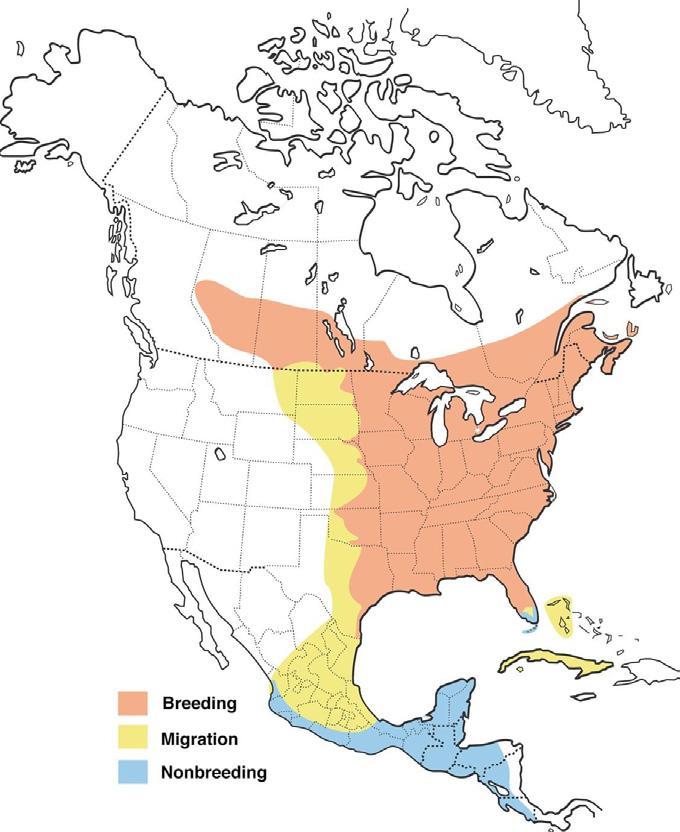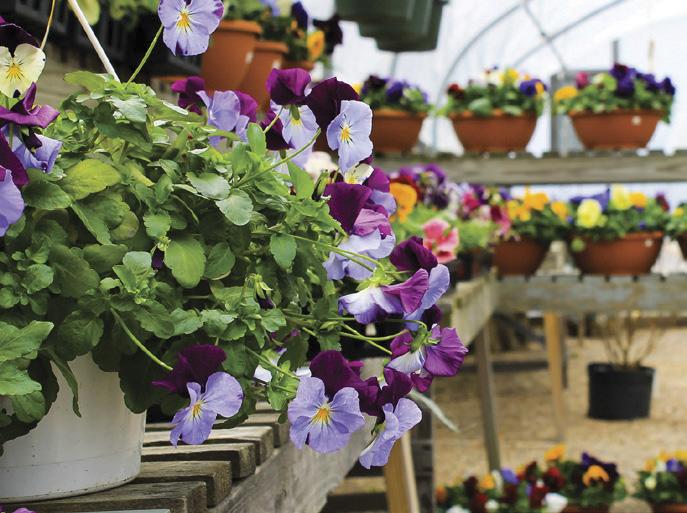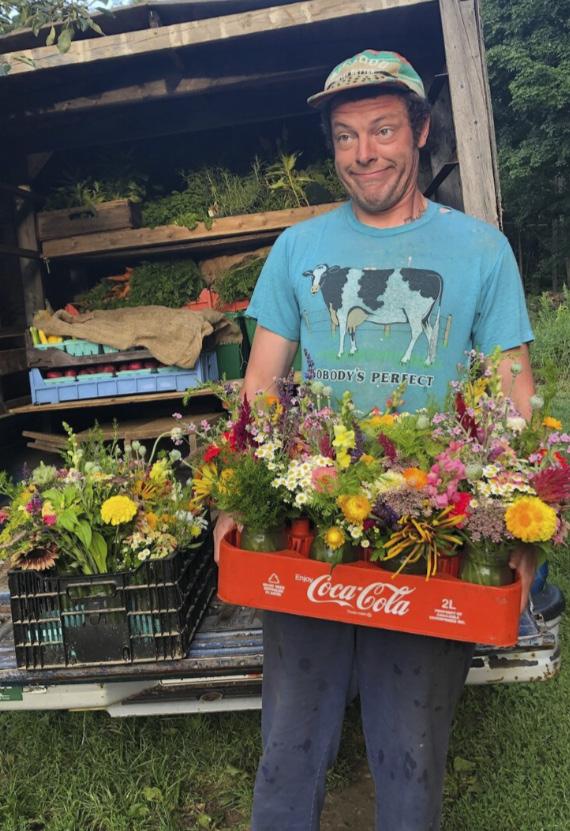
11 minute read
TOP 10 TIPS TO ATTRACT MORE HUMMINGBIRDS
TOP 10 THINGS YOU CAN DO TO ATTRACT MORE HUMMINGBIRDS by Bill Thompson, III | Editor, Bird Watcher’s Digest
Photo by Tori Jackson
Advertisement
The ruby-throated hummingbird is the most common hummingbird in New England and in the Northeast. It is the only North American hummingbird that nests east of the Mississippi and weighs just an eighth of an ounce. Its heart beats 250 times per minute while its wings clock about 50 times per second. Male ruby-throated hummingbirds have a shiny green back and ruby red throat (that may look black in certain lighting). The female birds are slightly larger, and have green backs with a white breast and throat. Females also have rounded tails with white tips, while the males have a forked tail with no white.
Flower nectar is a major part of the hummingbird’s diet. While consuming nectar, a hummingbird also collects pollen from one flower and deposits it on the reproductive parts of the next flower, thus providing the plant with a means of reproducing. To sustain their supercharged metabolisms, hummingbirds must eat once every 10 to 15 minutes and visit between 1,000 and 2,000 flowers per day. If you would like to attract more hummingbirds to your yard, read the following information originally produced by our friends at Bird Watcher’s Digest. Happy birding!
1. ADD A NEW NATIVE PLANT SPECIES TO YOUR GARDEN
You just can’t have too many good hummingbird plants in your garden or yard. Take an inventory of your existing offerings and consult a source of hummingbird plant information for ideas on what to add next. Good sources include plant charts in Enjoying Hummingbirds More, and Creating Your Backyard Bird Garden. Both titles are part of the BWD backyard booklet series, which can be ordered at www.redstartbirding.com/collections/booklets.
2. PLAN A CONTINUOUS BLOOMING SCHEDULE
When you’re leafing through your garden catalogs or wandering the greenhouses of your favorite garden center planning your hummingbird garden, choose plant species that have different blooming periods. For example, choose a ready-to-bloom hanging basket of fuschia for early flowers, a fast-growing Salvia species for midsummer flowers, and a late-blooming trumpet creeper that will be in flower in late summer and fall. Ask a local gardening expert for advice on blooming schedules and seasons for your area, soil type, and climate. Continuous blooming means hummingbirds will always have a reason to be in your yard, especially late in the season when flower production is down but hummingbird numbers are up, with all the recently fledged youngsters.
3. DEADHEAD YOUR FLOWERS TO ENHANCE BLOOMING
This old gardeners’ trick is a clever one. By removing old blossoms (this process is known as “deadheading”) shortly after they have wilted and removing seed heads from blooming plants, you trick the plants into thinking that their work is not yet done. The plants respond by continuing to produce flowers and seedheads, in the end producing far more than they would have if they had not been deadheaded. Later in the season, you
Ruby-Throated Hummingbird
Archilochus colubris
ORDER: Caprimulgiformes FAMILY: Trochilidae

Both Sexes Length: 2.8-3.5 in (7-9 cm) Weight: 0.1-0.2 oz (2-6 g) Wingspan: 3.1-4.3 in (8-11 cm)
can let the plants go to seed to ensure that you’ll have them back in your garden next year.
4. TIE AN ORANGE RIBBON ROUND THE OLD OAK TREE
Use foot-long pieces of surveyor’s tape (bright red or orange plastic ribbon sold in hardware stores) to catch the eyes of passing hummingbirds. Tie these pieces to bushes, trees, deck railings—anyplace near flowers or feeders. The bright colors will lure migrant hummingbirds down from the sky for a closer look.
5. REPAINT AND REHABILITATE YOUR OLD FEEDERS
If the red parts on your hummingbird feeders are getting a bit dull, you can repaint them using bright magenta nail polish. Make sure the nail polish is totally dry before you fill and place the feeder. When dry, the polish’s bright color is a visual signal to hungry hummers.
6. REPLACE OLD FEEDERS
Don’t want to waste good nail polish and elbow grease on rehabilitating your tired, old hummingbird feeders? Go buy some new feeders. This time, get durable, heavy plastic feeders. Make sure they are designed for easy filling and that they come apart for easy cleaning. If you still insist on getting El Cheapo feeders, start saving now to buy a new batch of feeders next spring.
7. MAKE SNAG PERCHES FOR HUMMINGBIRDS
Most birds like to use snags for perching. Why? To rest, to preen, but most of all, to hunt. Hummingbirds are no different. After beating your wings at a rate of 80 beats per second, you’d feel like taking a break, too. All hummingbirds, but especially males, like to perch on the end of an exposed branch. From this vantage point they can see danger or rivals approaching. And they can sally forth into the air to grab a tasty insect, should one happen to fly past. You can create a hummingbird snag by sticking a dead branch into the ground so that it stands vertically. Place it about 50 feet from your feeder, but still within view.
8. ADD A MISTER TO YOUR YARD
A mister is a small-hosed attachment for your regular garden hose. With the hose turned on to just a trickle, the mister, with
its pinhole openings, shoots a fine spray, or mist, into the air. Hummingbirds, like all birds, will regularly bathe if a ready supply of water is at hand. But a mister in action is too much to resist! Hummingbirds love to fly through the fine spray until they are thoroughly soaked, at which point they zip off to a handy preening perch. Misters are available at hardware stores, lawn and garden centers, specialty bird stores, and by mail order.
9. DON’T REMOVE THOSE SPIDER WEBS
Hummingbirds use spider webs as a main ingredient in their nests. Strands of spider web hold the nest together and to the branch upon which it is built. But wait, there’s more! Hummingbirds also love to steal insects from spider webs. Insects are an important source of protein for hummingbirds, and they’ll get them any way they can. How convenient for hummingbirds to have spider webs do the catching for them.
10. GOT BULLIES? ADD MORE FEEDERS IN A CLUMP!
If you have one male hummingbird that is dominating your feeder to the exclusion of all others, there are two ways to afford your other hummingbirds a drink. One is to put up other feeders on opposite sides of your house, or out of sight of Mr. Bully. Of course, this may simply mean that you are setting up other fiefdoms for other male bullies. Perhaps a better solution is to add two or three more feeders in the vicinity of the first feeder. This will attract multiple hummingbirds, which will quickly cure your bully of his territoriality. He will not be physically able to fight off all the other hummingbirds, so he will give up trying.
Special thanks to the Bird Watcher’s Digest for allowing this reprint. Visit them at www.birdwatchersdigest.com.
UNDER NEW OWNERSHIP
Current Hours: 8–5pm Tuesdays-Sundays
Our roots grow deep in our community

Shop outdoors on our 9 acres!

Purchase from our walk-up window
10% discount for seniors and veterans
McSherry’s Nursery (603) 447-5442 • McsherrysNursery.com 2599 East Main St. Center Conway, NH

The searchlights are fired up and the beam blasts forth into the night sky, the crowds stand hushed as an icon of pure illumination shines in the moonlit clouds. Maybe it’s a fist holding a bunch of carrots or maybe it’s a rolling pin—a clarion call that says now, more than ever, we need our unlikely hero: the local food system.
Meanwhile, someplace beyond the sunbaked parking lots of our struggling modern food system, someplace maybe down the street from you, on a farm, in a backyard, on a rooftop, or in a city park, there is our to feed a baby or make kale chips. But that time ended as we watched the modern food system groan beneath the weight of demand.
Now, at least, we know how fragile we are. Lucky for us our local food system is a plucky son of a gun—callouses on the hands and feet from the thin years of never really having a dime, and an easy handshake from all the years spent as a neighbor, a board member, a parent, a caretaker, and an actual living and breathing human being. The local food system fixes a bird’s wing, patches a tire and delivers an order, stops along the road to pick
Old Wells Farm photo
Stowell Watters lives with his family in Limington, ME, and runs Old Wells Farm.
The local food system is a butcher, a baker, and a candlestick maker, a farmer in the dell, and a neat old man with a curling mustache and a beautiful smile who can saunter into the woods and come out with an armful of mushrooms and berries that wont kill you ... and hey, actually, these are pretty good …
unlikely hero, getting boots tied on (no cape here, folks), stretching to get that kink out of the back (a little to the left; yes, that’s it), and now to the coffee machine—hot and bitter, perfect. On to a new opportunity and lots of work to do: rows to hoe, bees to see, dough to knead, and people to feed. Know this: the local food system is up to the challenge, maybe even a little excited, and already on its second cup when the news comes across the wire that we are a nation in need.
There was a time, maybe even as recent as this winter, when we could look upon our local food system as an indulgence; something fun to dabble in when the in-laws came over. “Oh, this chicken is organic. We bought it at the farmers’ market. Charming place, really— everyone in muck boots!” Or when it came time up some garbage and throw it in the truck, drinks some more coffee, and then is off to the softball game. The local food system is a butcher, a baker, and a candlestick maker, a farmer in the dell, and a neat old man with a curling mustache and a beautiful smile who can saunter into the woods and come out with an armful of mushrooms and berries that won’t kill you … and hey, actually, these are pretty good …
Our future is always uncertain, and we are all connected; we know that now, too. Maybe we knew it before, but now we—capital K— Know it for real. What you do affects him which affects her which affects me. The local food system is one of mutual benefit; every dollar spent in the local food system is re-spent and reinvested in the local school system or the
Old Wells Farm photo

municipal system or the local service sector or even the local game store. The money hangs out, percolates, empowers.
The local food system is flexible (must be all those downward dogs). If he can’t grow it, I bet she can. The lo- cal food system is not troubled by a downturn of the stock market, it folds the newspaper up and turns to the weather or the funnies. The local food system is not at all—in any way, shape, or form—beholden to the whims and wishes of a yacht-load of plutocrats. It is decentralized and power- ful, able to adapt and change, and has been in the barn doing push-ups and crunches for the last few months. So, hey, actually, it’s looking pretty good …
The local food system is not an indulgence; it is es- sential to our way of life. The local food system is here and ready to help the modern food system. It puts out a strong arm and pulls the poor thing to its feet, brushes off its suit, and looks it in the eye—like we all look each other in the eye when important things need to be said—to say: Hey, we can do this, but we need to do it together from here on out.
The message is that we all just want everyone to be okay. We want our environment to not die. We want to see animals in the woods. We want people to get food and medicine when they need it. The message is that the local food system is uniquely capable of fulfilling these desires.
Old Wells Farm is in Limington, Maine and is made up of Stowell Watters, Marina Steller, Dottie Jo, Dylan Watters, Alaena Robbins, and a host of friends, family, and animals. The farm is organic certified with an emphasis on perma- culture techniques, no till diversified vegetable production, flowers, pork, maple syrup, honey, mushrooms, and future endeavors unknown.
Inn & Tavern ILDCAT
Engravers Roman BT
Cataneo
r e s t a u r a n t & t a v e r n
Restaurant & Pub
lmost hereT








